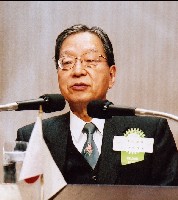��Japanese people��s personality, and Education and Health��
November 29, 2006
Mr. Yasuo Kagawa,
Vice-president, Kagawa Nutrition University
 I think the people know, if they have a living experience in foreign countries, the difference in character between Japanese and Westerners. Japanese often take self-deprecating attitudes, or say, ��Thank you for listening to my clumsy story�ġ� when speaking to an audience. Some call it modesty, but the expression or attitude may be a disposition to perfectly rely on the patience of the audience. In contrast, an American might start with a joke or funny tale, making them laugh. It is like they are telling the audience ��my speech is worth listening to.��
I think the people know, if they have a living experience in foreign countries, the difference in character between Japanese and Westerners. Japanese often take self-deprecating attitudes, or say, ��Thank you for listening to my clumsy story�ġ� when speaking to an audience. Some call it modesty, but the expression or attitude may be a disposition to perfectly rely on the patience of the audience. In contrast, an American might start with a joke or funny tale, making them laugh. It is like they are telling the audience ��my speech is worth listening to.��
I used to work at Cornell University as a visiting professor for three years. Then, I came back to Japan and taught at Jichi Medical University. The students in the U.S. took front seats in a classroom and questioned a lot, whereas those in Japan took back seats in the room and were very quiet.
When I was teaching at Jichi Medical University, the pass rate of national exam for medical practitioners amounted almost to 100 percent. The obligation rate of medical students to work in outposts was 97 percent, and most of them stayed in each rural area even after executing their duty. The university was also excellent in sports. The graduates, or practitioners were assessed by their outposts or each prefecture, in terms of personality, skill, and performance for 30 years. The data, along with the evaluation at the university for the student��s life from interview in entering university to the six years�� activities in the boarding school, were valuable from an educational perspective.
After I transferred to Kagawa Nutrition University from Jichi Medical University, the nation��s education system had a significant failure. Educational globalization-in a good way it is ��self-directed learning,�� but in an opposite way it is a system of ��let students alone��-occurred. Sports and basic science became initial selective subjects for students. Because of this, Jichi Medical University��s ranking in the pass rate of students in the national exam for medical practitioners deteriorated to 38th among other 80 national medical universities, and, as a result of reduced number of students belonging to a sport club, the level of students�� physical ability also sharply dropped to rank 20th out of 40 medical universities of East Japan.
I returned to Jichi Medical University. Sports as a compulsory subject, and rigorous classes also returned. Then, the pass rate of the national exam for medical practitioners also returned to 100 percent for three years from 2003 to 2005, and the physical level improved as well.
Why was the successful ��education free from pressure�� in the U.S. a failure in Japan?
According to data in a percentage of the frequency of gene polymorphism from the serotonin transporter gene-one of the character genes-Japanese consist of 70 percent of SS-type, or characters of reluctant and flexible, and 30 percent of LS-type for independency and positivity. Americans are composed of a little less than 20 percent of SS-type, nearly 50 percent of LS-type, and a little over 30 percent of LL-type or super positivity. Super positivity for Japanese consists only of less than 2 percent.
Successful education is to apply methods adequate to students with different characters. Therefore, independency-oriented learning is good for American students, and a thorough and detailed approach must be good for Japanese students.
So far I have discussed educational issues. From now, I would like to present a theme of our health by focusing on rapidly increased adult diseases under westernized eating habits.
Japanese have a lot of thrifty genes. The energy excess resulting from their diet has led many Japanese to being affected with abnormal glucose tolerance, causing diabetes, and hyperlipidemia, causing strokes (cerebral thrombosis) and heart attacks (heart infarction).
The Japanese government advocated a ��Health Japan 21�� policy in 2000. It was a promotion of letting Japanese stay in good health. However, the policy has not achieved good results, nor has it relieved obesity-in fact, cancer is increasing. Contrary to this, the U.S. ��Healthy People 2000�� largely declined cancer and heart attacks. Japanese with SS-type genes like to avoid trouble-filled behavior. So, the national health promotion policy failed because behaviors didn��t change, not from lack of knowledge.
Voluntary actions are inadequate to Japanese with SS-type genes. Thus, if you wish for a successful lecture, the lecture must be focused on a small number of people or a group, not a large number of people. Then after the lecture, individual guidance should be provided in a courteous manner. Indeed, the nutritional clinic at Kagawa Nutrition University is a taking thorough and detailed approach, on an individual basis, and has achieved weight control, improved lipids in serum, and improved blood pressure and glucose.
The grounds for the increasing number of people with SS-type character genes and anti-starvation resistance genes can be obtained from the rice culture by people in the Yayoi Era, which continued for several thousand years. Rice cultivation required a rigid and stern community, in which people with LL-type genes were rejected because of their selfishness. I think that because rice of tropical plants encountered severe famine once in ten years due to climate changes, people with anti-starvation resistance genes helped each other for their survival.